family
 In areas of the country that are more rural, most everyone has their own car, and while we have bus systems, the majority of people drive themselves to do their errands and such. In large metropolis places, like New York City, however, where parking is hard to find, and costs a fortune, many people choose not to own a vehicle. That said, getting around there is not as easy as it is for those of us who simply go out and get in our car, and drive away. For New York City the best solution was to build a subway. As most people know, a subway is a rapid transit system. The one in New York City serves four of the five boroughs of New York City, including the Bronx, Brooklyn, Manhattan, and Queens. The subway is operated by is the New York City Transit Authority (NYCTA), which is controlled by the Metropolitan Transportation Authority (MTA) of New York. In 2016 alone, an average of 5.66 million passengers used the system every day, making it the busiest rapid transit system in the United States and the seventh busiest in the world.
In areas of the country that are more rural, most everyone has their own car, and while we have bus systems, the majority of people drive themselves to do their errands and such. In large metropolis places, like New York City, however, where parking is hard to find, and costs a fortune, many people choose not to own a vehicle. That said, getting around there is not as easy as it is for those of us who simply go out and get in our car, and drive away. For New York City the best solution was to build a subway. As most people know, a subway is a rapid transit system. The one in New York City serves four of the five boroughs of New York City, including the Bronx, Brooklyn, Manhattan, and Queens. The subway is operated by is the New York City Transit Authority (NYCTA), which is controlled by the Metropolitan Transportation Authority (MTA) of New York. In 2016 alone, an average of 5.66 million passengers used the system every day, making it the busiest rapid transit system in the United States and the seventh busiest in the world.
As New York City grew (it currently has 10 times the amount of people as Wyoming – the smallest state by population), it became obvious that there was going to have to be a public transport system. Work began on  the New York Subway on March 24, 1900, and the first underground line opened on October 27, 1904. The opening of the subway was almost 35 years after the opening of the first elevated line in New York City, which became the IRT Ninth Avenue Line. By the time the first subway opened, the two elevated lines had been consolidated into two privately owned systems, the Brooklyn Rapid Transit Company (BRT, later Brooklyn–Manhattan Transit Corporation, BMT) and the Interborough Rapid Transit Company (IRT). All lines built for the IRT and most lines for the BRT were built by the city and leased to the companies after 1913. When the first line of the city-owned and operated Independent Subway System (IND) opened in 1932, it was intended to compete with the private systems and replace some of the elevated railways. The problem was that it was required to be run “at cost,” By necessity, the fares were up to double the five-cent fare, that was popular at the time…thereby, completely defeating the intended purpose.
the New York Subway on March 24, 1900, and the first underground line opened on October 27, 1904. The opening of the subway was almost 35 years after the opening of the first elevated line in New York City, which became the IRT Ninth Avenue Line. By the time the first subway opened, the two elevated lines had been consolidated into two privately owned systems, the Brooklyn Rapid Transit Company (BRT, later Brooklyn–Manhattan Transit Corporation, BMT) and the Interborough Rapid Transit Company (IRT). All lines built for the IRT and most lines for the BRT were built by the city and leased to the companies after 1913. When the first line of the city-owned and operated Independent Subway System (IND) opened in 1932, it was intended to compete with the private systems and replace some of the elevated railways. The problem was that it was required to be run “at cost,” By necessity, the fares were up to double the five-cent fare, that was popular at the time…thereby, completely defeating the intended purpose.
While the city tried to keep the elevated system running too, and succeeded to a degree, many were had to be closed, because it became too expensive to maintain them. Graffiti, crime, and dilapidation became common. The New York City Subway had to make many service cutbacks and defer necessary maintenance projects just to stay solvent. In the 1980s an $18 billion financing program for the rehabilitation of the subway began. Today, the subway systems remain an important part of the transport system, in New York City. They are also vulnerable to attack, as well as simple maintenance problems. The September 11 attacks prove this without question. The attacks resulted in service disruptions, particularly on the IRT Broadway–Seventh Avenue Line, which ran directly underneath the World Trade Center. Several sections were crushed, requiring suspension of  service on that line south of Chambers Street. Work began immediately to repair the damage, and by March 2002, seven of the closed stations had been rebuilt and reopened. All but one of them. Then, on September 15, 2002, that one also reopened with full service along the line. Since the 2000s, expansions include the 7 Subway Extension that opened in September 2015, and the Second Avenue Subway, the first phase of which opened on January 1, 2017. However, at the same time, under-investment in the subway system led to a transit crisis that peaked in 2017. Subways will most likely always be an important part of transportation, especially in big cities. Nevertheless, it will also always have its vulnerabilities.
service on that line south of Chambers Street. Work began immediately to repair the damage, and by March 2002, seven of the closed stations had been rebuilt and reopened. All but one of them. Then, on September 15, 2002, that one also reopened with full service along the line. Since the 2000s, expansions include the 7 Subway Extension that opened in September 2015, and the Second Avenue Subway, the first phase of which opened on January 1, 2017. However, at the same time, under-investment in the subway system led to a transit crisis that peaked in 2017. Subways will most likely always be an important part of transportation, especially in big cities. Nevertheless, it will also always have its vulnerabilities.

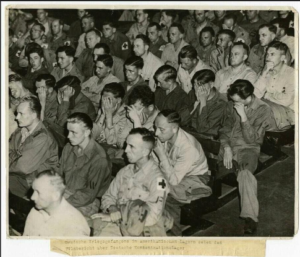 Adolf Hitler was quite possibly one of the most insane people of all time, but apparently much of the hateful things he did were actually done under the influence of Opioids and Meth. Does that excuse his behavior? Absolutely not. Even on opioids and meth, there was a monster that existed deep on the inside of that man. There was a deep-seated hatred that made him do the things he did. The opioids and meth merely gave him the ability to continue on in his hatred, and it wasn’t just Hitler that was regularly using these drugs to carry out their hateful tasks. It is common knowledge that many of the soldiers under Hitler either didn’t know the truth of everything that was going on, and still others were afraid to argue the point for fear of their own death. For many of those people, the use of drugs was the only escape from the horrors of what they had to do.
Adolf Hitler was quite possibly one of the most insane people of all time, but apparently much of the hateful things he did were actually done under the influence of Opioids and Meth. Does that excuse his behavior? Absolutely not. Even on opioids and meth, there was a monster that existed deep on the inside of that man. There was a deep-seated hatred that made him do the things he did. The opioids and meth merely gave him the ability to continue on in his hatred, and it wasn’t just Hitler that was regularly using these drugs to carry out their hateful tasks. It is common knowledge that many of the soldiers under Hitler either didn’t know the truth of everything that was going on, and still others were afraid to argue the point for fear of their own death. For many of those people, the use of drugs was the only escape from the horrors of what they had to do.
Still, there were many people who were truly evil, and it’s quite likely that those people simply used the drugs to “enhance” the horrific experience, and by enhance, I mean they very much enjoyed the killing and in their twisted minds, the use of the drugs made it more “pleasurable” to do the things they did. The drugs also kept the Nazis awake for many more hours than they might otherwise have been able to endure. The Nazi call was “Germany awake!” The orders were constantly barked out, and they meant it more than most people even knew. As Nazi Germany battled its way through World War II, the country relied on a little secret to stay “energetic.” It was known as Pervitin. It was used by the soldiers to avoid sleep and to numb the terror of battle. Housewives later popped Pervitin so they could “finish all their chores and lose weight” too. It turns out, however, that it was just pure methamphetamine. And Adolf Hitler himself relied on even stronger remedies, taking a drug called Eukodal, effectively a cocktail of oxycodone and cocaine, to treat various “ailments.”
By 1941, a top German health minister wrote a letter fretting that the entire nation was “becoming addicted to drugs” but it made little difference to Hitler or anyone else. Indeed, there remains a “trove of weird historical facts about drug use in Nazi Germany” that would totally astound even World War II buffs. We already knew that Hitler was evil and crazy, but now we know more about how he was able to keep going with all his hate. 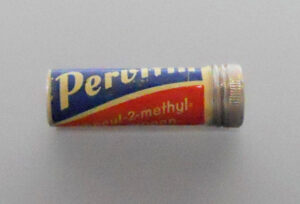
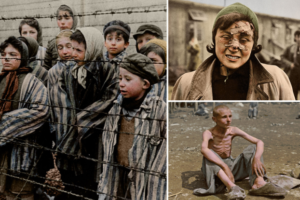 For some or most of the soldiers, it was likely a way to control what they did. I’m sure a ‘mutiny” would have been catastrophic for Hitler’s master plan against the Jews. When some of those soldiers saw the atrocities that occurred, they actually wept. Many of them had no idea what was really going on…and I’m sure that was exactly what Hitler wanted.
For some or most of the soldiers, it was likely a way to control what they did. I’m sure a ‘mutiny” would have been catastrophic for Hitler’s master plan against the Jews. When some of those soldiers saw the atrocities that occurred, they actually wept. Many of them had no idea what was really going on…and I’m sure that was exactly what Hitler wanted.

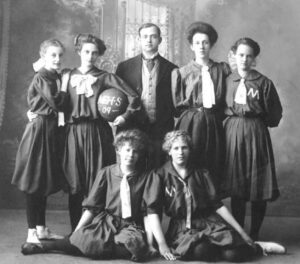 These days, women’s sports are as popular as men’s sports, but women’s sports have not always been a thing. In fact, until March 22, 1893, when the first women’s college basketball game was played at Smith College in Northampton, Massachusetts, there was no such thing…not in college anyway. There were women’s sports before that…even as far back as the 6th century, but they were not something that men watched. In 1893, the idea of men watching women play basketball was…unthinkable. These things were considered improper and leud. That all changed with the game at Smith College. In that game, each basket counted as one point and the game lasted two 15-minute halves. In the game, the sophomore class team prevailed over a freshmen team, 5-4. It must have been a great game, but men were still not permitted inside the gym at the all-women college. Still, it was women’s basketball, and a crowd of fascinated women cheered on their fellow classmates from the running track of the campus gymnasium. They were making history, and everyone was excited about it. The winning team was awarded a gold and white banner, but the bigger win that day was that collegiate history had been made, and women’s sports was now and forevermore a definite thing!!
These days, women’s sports are as popular as men’s sports, but women’s sports have not always been a thing. In fact, until March 22, 1893, when the first women’s college basketball game was played at Smith College in Northampton, Massachusetts, there was no such thing…not in college anyway. There were women’s sports before that…even as far back as the 6th century, but they were not something that men watched. In 1893, the idea of men watching women play basketball was…unthinkable. These things were considered improper and leud. That all changed with the game at Smith College. In that game, each basket counted as one point and the game lasted two 15-minute halves. In the game, the sophomore class team prevailed over a freshmen team, 5-4. It must have been a great game, but men were still not permitted inside the gym at the all-women college. Still, it was women’s basketball, and a crowd of fascinated women cheered on their fellow classmates from the running track of the campus gymnasium. They were making history, and everyone was excited about it. The winning team was awarded a gold and white banner, but the bigger win that day was that collegiate history had been made, and women’s sports was now and forevermore a definite thing!!
Women have participated in sports for many years, but it was never competitive, until that day. The “instigator” of the event was the college’s gymnastics instructor, Lithuanian immigrant Senda Berenson. Basketball hadn’t been around very long, in fact, it was just two short years since its invention by Dr James Naismith in late 1891. Berenson adapted the women’s rules from Naismith’s rules for men. Because of this adaptation, basketball became one of the rare sports that developed the male and female versions on a parallel timeline. We all know what basketball is like today. We have watched as the athletes jump up to “slam dunk” the ball into the soft net (made of synthetic fibers), grab the rim, and then let it go, making a bouncing ringing sound as it is released. The “basket” these days has an open bottom, making it not a true basket. The baskets of the past truly were a basket…usually a peach basket, with a closed bottom. The object of the game was to land a soccer ball into peach baskets suspended at opposite ends of a court.
The rules intentionally limit physical contact, but things don’t always go as planned. In that first competitive women’s game, a player on the freshmen team dislocated her shoulder at the beginning of the game, leaving her team a player down for the rest of the game. Versions of Berenson’s game quickly spread to other women’s 
 colleges throughout the country. Women’s competitive basketball was born. The first women’s intercollegiate game was between Stanford and Cal, and was played in 1896. Berenson, who died in 1954, was enshrined in the Naismith Basketball Hall of Fame as a contributor in 1985. She was inducted into the Women’s Basketball Hall of Fame in 1999.
colleges throughout the country. Women’s competitive basketball was born. The first women’s intercollegiate game was between Stanford and Cal, and was played in 1896. Berenson, who died in 1954, was enshrined in the Naismith Basketball Hall of Fame as a contributor in 1985. She was inducted into the Women’s Basketball Hall of Fame in 1999.
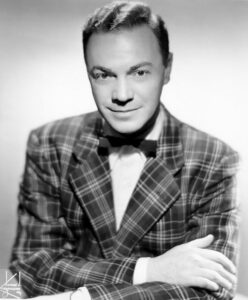
 Pretty much everyone these days has been to a music concert. It may have been Rock-and-Roll, Country, Pop, Rap, or any number of others, but concerts are here to stay. So, how did they get here? The event that is now recognized as history’s first major rock-and-roll show actually started out as a dance called the Moondog Coronation Ball, held of March 21, 1952, in Cleveland, Ohio. It was initiated by host Alan Freed, at the suggestion of Cleveland record-store owner Leo Mintz, who decided to sponsor three hours of late-night programming on WJW to showcase rhythm-and-blues music. Alan Freed was then installed as host. Freed quickly took to the task, adopting a new, hip persona and vocabulary that included liberal use of the phrase “rock and roll” to describe the music he was now promoting. It must have been an exciting time for him, to be there for the invention of concerts.
Pretty much everyone these days has been to a music concert. It may have been Rock-and-Roll, Country, Pop, Rap, or any number of others, but concerts are here to stay. So, how did they get here? The event that is now recognized as history’s first major rock-and-roll show actually started out as a dance called the Moondog Coronation Ball, held of March 21, 1952, in Cleveland, Ohio. It was initiated by host Alan Freed, at the suggestion of Cleveland record-store owner Leo Mintz, who decided to sponsor three hours of late-night programming on WJW to showcase rhythm-and-blues music. Alan Freed was then installed as host. Freed quickly took to the task, adopting a new, hip persona and vocabulary that included liberal use of the phrase “rock and roll” to describe the music he was now promoting. It must have been an exciting time for him, to be there for the invention of concerts.
The name of the event came from Alan Freed himself, who hosted the enormously popular “Moondog Show” on Cleveland AM radio station WJW. He was initially hired in 1951 to be the host of a classical-music program, but when Mintz told Freed about the trend he was watching among his young customers…of all races toward rhythm-and-blues records by black musicians, Freed took his career in a different direction. The two men got together and decided to promote the new show by having a dance and concert to promote those hot new artists. With that, the Moondog Coronation Ball was born. With the promotion kicked into high gear on the local radio station, tickets sold out in a single day. Still, that didn’t stop thousands of teenagers from lining up outside the biggest venue in town in the hours before show time. These days, we would think a riot was about to take place, and…maybe it was. It was a chilly Friday night in Cleveland, and outside the Cleveland Arena the scene would look quite familiar to anyone who has ever attended a major rock concert. But no one on this particular night had ever even heard of a “rock concert” before, much less stood in line for one.
On tap for “The Moondog Coronation Ball” were headliners Paul Williams and his Hucklebuckers, as well as Tiny Grimes and the Rocking Highlanders (a black instrumental group that performed in Scottish kilts). While musicians who have to cancel, or problems with equipment have been known to shut down an event, no one could have expected that the incredible demand for tickets proved to be the event’s undoing. The problem was exacerbated by massive ticket counterfeiting and possibly by overbooking on the part of the event’s sponsors. The arena had a capacity of 10,000 people, but an estimated 20,000 to 25,000 fans turned out for an event. Those fans who could not get in, though they held a ticket, legal or not, were trying to gain entry. Less than an hour into the show, the massive overflow crowd broke through the gates that were keeping them outside. In an effort to save lives, the police quickly moved in to stop the show almost as soon as it began. The angry fans 
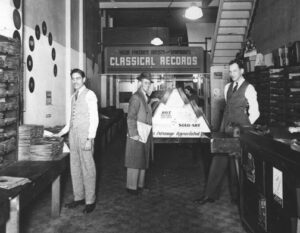 wanted an explanation. On the radio the very next evening, Alan Freed offered an apology to listeners who had tried to attend the canceled event. The only thing he could do was to be honest with them and apologize. Freed told his fans, “If anyone…had told us that some 20,000 or 25,000 people would try to get into a dance, I suppose you would have been just like me. You would have laughed and said they were crazy.” The “failure” of the Moondog Coronation Ball was actually its success. Who could have known?
wanted an explanation. On the radio the very next evening, Alan Freed offered an apology to listeners who had tried to attend the canceled event. The only thing he could do was to be honest with them and apologize. Freed told his fans, “If anyone…had told us that some 20,000 or 25,000 people would try to get into a dance, I suppose you would have been just like me. You would have laughed and said they were crazy.” The “failure” of the Moondog Coronation Ball was actually its success. Who could have known?
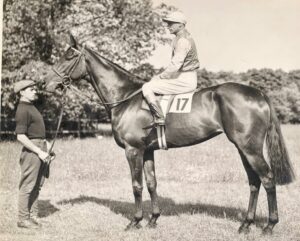 In horse racing there are several races which are the most prestigious races and the most sought-after wins. One of these is held at Belmont Park, a thoroughbred horse racetrack in Elmont, New York, just east of New York City limits best known for hosting the Belmont Stakes, the final leg of the American Triple Crown. It was opened on May 4, 1905, and is one of the best well known racetracks in the United States. I’m sure that over the years, there have been a number of shocking wins at Belmont Park, as with any other race, but few, if any, of them can lay claim to the strangeness of the June 4, 1923, win at Belmont Park.
In horse racing there are several races which are the most prestigious races and the most sought-after wins. One of these is held at Belmont Park, a thoroughbred horse racetrack in Elmont, New York, just east of New York City limits best known for hosting the Belmont Stakes, the final leg of the American Triple Crown. It was opened on May 4, 1905, and is one of the best well known racetracks in the United States. I’m sure that over the years, there have been a number of shocking wins at Belmont Park, as with any other race, but few, if any, of them can lay claim to the strangeness of the June 4, 1923, win at Belmont Park.
Frank Hayes, who was born in 1901 (there is some dispute on his date of birth, with some saying 1888) was an Irish horse trainer and jockey who. As both trainer and jockey, each win was especially sweet. Still, like most big goals, sometimes you had to pay your dues before you finally got that win. The twenty-two-year-old Hayes had never won a race before, because technically, he was not a jockey, but a horse trainer and stableman. Working in that capacity, Hayes was just biding his time until the day when he would actually get to be the jockey in a race.
That day came on June 4, 1923. Hayes was riding a horse called Sweet Kiss, owned by Miss A M Frayling. Sweet Kiss had been given 20:1 odds of winning. Basically, that meant that Sweet Kiss winning was highly 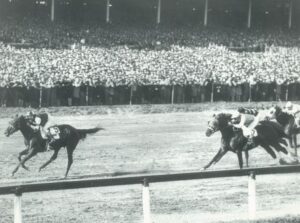 unlikely. With those odds, there really wasn’t much stress on Hayes, which he probably felt was a good thing for his first race. Hayes already had enough stress going on, because he was heavy for a jockey. It’s possible that he knew that he may not have a long career as a jockey, because he was simply bigger than the average jockey. That said, Hayes began an extreme slimming effort to meet the weight requirements and dropped his weight from 142 pounds to 130 pounds at the time of the race.
unlikely. With those odds, there really wasn’t much stress on Hayes, which he probably felt was a good thing for his first race. Hayes already had enough stress going on, because he was heavy for a jockey. It’s possible that he knew that he may not have a long career as a jockey, because he was simply bigger than the average jockey. That said, Hayes began an extreme slimming effort to meet the weight requirements and dropped his weight from 142 pounds to 130 pounds at the time of the race.
In the latter part of the race, a two mile, 12-jump steeplechase, Hayes suffered a fatal heart attack, but somehow his body stayed in the saddle. The spectators thought that Hayes was showboating his win, slumped over and riding with one hand, “relaxed as a dog sleeping in front of a fireplace.” In reality, Sweet Kiss had to have been an exceptional horse, because even without her rider making the usual encouraging maneuvers to push her forward to the win, Sweet Kiss and her dead jockey, crossed the finish line, winning by a head, making Hayes the first, and so far, only jockey known to have won a race after death. Hayes’ death was not discovered until Miss Frayling and race officials came to congratulate him shortly after the race, at which point the shocking phenomenon was discovered. It is thought that the fatal heart attack may have been brought on by Hayes’ extreme weight loss efforts. Losing so much weight in such a short time is very hard on the body and especially the heart.
Following the discovery of Hayes’ death, all the normal post-race formalities were waived by the Jockey Club. 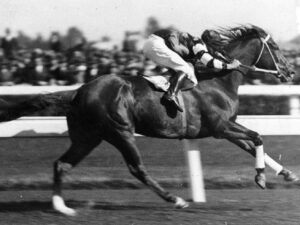 The results of the race were declared official without the post-race weigh in. Frank Hayes was buried three days later, dressed in his beloved racing silks at Holy Cross Cemetery in Brooklyn, New York City. It is definitely what he would have wanted, because racing was all he ever wanted to do. Sweet Kiss never raced again, and it is claimed that the horse was nicknamed “Sweet Kiss of Death” for the rest of her life. I suppose no other jockey would want to ride the horse, since jockeys can be a superstitious bunch. Personally, the tragic death aside, I think that Sweet Kiss had to have been a wonderful horse. Not only did she win the race, but she didn’t lose her rider. It is sad that Hayes died during his one and only race, but I’m sure he was happy to be going out a winner.
The results of the race were declared official without the post-race weigh in. Frank Hayes was buried three days later, dressed in his beloved racing silks at Holy Cross Cemetery in Brooklyn, New York City. It is definitely what he would have wanted, because racing was all he ever wanted to do. Sweet Kiss never raced again, and it is claimed that the horse was nicknamed “Sweet Kiss of Death” for the rest of her life. I suppose no other jockey would want to ride the horse, since jockeys can be a superstitious bunch. Personally, the tragic death aside, I think that Sweet Kiss had to have been a wonderful horse. Not only did she win the race, but she didn’t lose her rider. It is sad that Hayes died during his one and only race, but I’m sure he was happy to be going out a winner.
 These days, we look forward to the eclipses that happen periodically with anticipation. People will even make travel plans to be at the best location to see the eclipse at its fullest coverage. This was not always the case, however. Eclipses of the distant past could even invoke fear among the people who witnessed them. Of course, in those days, they most likely didn’t know it was coming, or even what it was. On May 28, 585 BC such an eclipse occurred.
These days, we look forward to the eclipses that happen periodically with anticipation. People will even make travel plans to be at the best location to see the eclipse at its fullest coverage. This was not always the case, however. Eclipses of the distant past could even invoke fear among the people who witnessed them. Of course, in those days, they most likely didn’t know it was coming, or even what it was. On May 28, 585 BC such an eclipse occurred.
At the time of the eclipse, the Medians and Lydians were in the middle of a vicious battle. I’m sure they didn’t notice the eclipse at first, but as it became darker and darker, the situation had to seem very strange. Before long, they forgot about the vicious battle they were fighting and ran off the battlefield. “The Eclipse of Thales” was a solar eclipse that was, according to ancient Greek historian Herodotus,  actually predicted accurately by the Greek philosopher Thales of Miletus. In fact, it is probably the earliest recorded as being known in advance of its occurrence, and it is believed to be the solar eclipse of May 28, 585 BC. It is not known exactly how Thales predicted the eclipse, and some scholars don’t actually believe the eclipse was ever predicted at all. Others think it was on a different date, but the eclipse of May 585 BC best matches the conditions of visibility necessary to explain the historical event.
actually predicted accurately by the Greek philosopher Thales of Miletus. In fact, it is probably the earliest recorded as being known in advance of its occurrence, and it is believed to be the solar eclipse of May 28, 585 BC. It is not known exactly how Thales predicted the eclipse, and some scholars don’t actually believe the eclipse was ever predicted at all. Others think it was on a different date, but the eclipse of May 585 BC best matches the conditions of visibility necessary to explain the historical event.
According to Herodotus, the appearance of the eclipse was actually interpreted as an omen. It is believed to 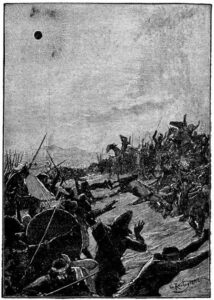 have interrupted a battle in a long-standing war between the Medes and the Lydians. American writer Isaac Asimov described this battle as “the earliest historical event whose date is known with precision to the day.” The prediction has since been called “the birth of science.” According to historical records, that eclipse “peaked over the Atlantic Ocean at 37.9°N 46.2°W and the umbral path reached south-western Anatolia in the evening hours.” The Halys River, which is the presumed site of the battle mentioned by Herodotus, was just at the edge of the margin of error for the positioning of the eclipse. Herodotus’ The Histories 1.73–74 states that “a war started in that period between the Medes and the Lydians.” Apparently, the combatants became so distraught about the darkening conditions, that they actually ran off of the battlefield. Basically saying…”I’m outta here!!” That would be an interesting end to a battle, and it makes me wonder if they were later laughed at for their “cowardice in battle!!”
have interrupted a battle in a long-standing war between the Medes and the Lydians. American writer Isaac Asimov described this battle as “the earliest historical event whose date is known with precision to the day.” The prediction has since been called “the birth of science.” According to historical records, that eclipse “peaked over the Atlantic Ocean at 37.9°N 46.2°W and the umbral path reached south-western Anatolia in the evening hours.” The Halys River, which is the presumed site of the battle mentioned by Herodotus, was just at the edge of the margin of error for the positioning of the eclipse. Herodotus’ The Histories 1.73–74 states that “a war started in that period between the Medes and the Lydians.” Apparently, the combatants became so distraught about the darkening conditions, that they actually ran off of the battlefield. Basically saying…”I’m outta here!!” That would be an interesting end to a battle, and it makes me wonder if they were later laughed at for their “cowardice in battle!!”
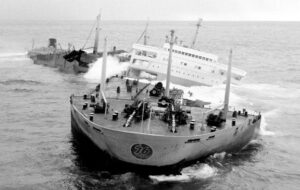 SS Torrey Canyon was a supertanker that was responsible for one of the world’s most serious oil spills. The Torrey Canyon ran aground on rocks off the south-west coast of the United Kingdom in 1967. In all 25 -36 million gallons of crude oil was spilled. There were a number of attempts to mitigate the damage, one of which was to actually bomb the wreck by aircraft from the Royal Navy and Royal Air Force. I guess they thought the bombing would burn up the oil. Unfortunately, that was not the case, and hundreds of miles of coastline in Britain, France, Guernsey, and Spain were affected by the oil spill and other substances used in the attempt to mitigate damage. Even the “solution” was a big problem. The disaster was the world’s worst oil spill and led to significant changes in maritime law and oil spill responses.
SS Torrey Canyon was a supertanker that was responsible for one of the world’s most serious oil spills. The Torrey Canyon ran aground on rocks off the south-west coast of the United Kingdom in 1967. In all 25 -36 million gallons of crude oil was spilled. There were a number of attempts to mitigate the damage, one of which was to actually bomb the wreck by aircraft from the Royal Navy and Royal Air Force. I guess they thought the bombing would burn up the oil. Unfortunately, that was not the case, and hundreds of miles of coastline in Britain, France, Guernsey, and Spain were affected by the oil spill and other substances used in the attempt to mitigate damage. Even the “solution” was a big problem. The disaster was the world’s worst oil spill and led to significant changes in maritime law and oil spill responses.
The Torrey Canyon was built in the United States in 1959. She originally had a capacity of 60,000 tons, but that was later enlarged to 120,000 tons in Japan. She was named for Torrey Canyon, a valley located in Ventura County, California. SS Torrey Canyon was registered in Liberia and owned by Barracuda Tanker Corporation, which is a subsidiary of Union Oil Company of California, but she was chartered to British Petroleum. SS Torrey Canyon was 974.4 feet long, with a 125.4 feet beam and a 68.7 feet draught.
On February 19, 1967, SS Torrey Canyon began what was to be her final voyage. She left the Kuwait National Petroleum Company refinery at Mina Al-Ahmadi, Kuwait, which was later called Al-Ahmadi, with a full cargo of crude oil. The ship was bound for Milford Haven in Wales. By March 14, she reached the Canary Islands. After 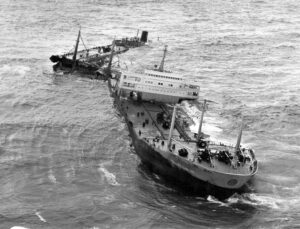 that, things went wrong. It all started with a navigational error and ended when Torrey Canyon struck Pollard’s Rock on the extreme Western end of the Seven Stones between the Cornish mainland and the Isles of Scilly on March 18, 1967.
that, things went wrong. It all started with a navigational error and ended when Torrey Canyon struck Pollard’s Rock on the extreme Western end of the Seven Stones between the Cornish mainland and the Isles of Scilly on March 18, 1967.
Because SS Torrey Canyon did not have a scheduled route and she also didn’t have the necessary complement of full-scale charts of the Scilly Islands. Before long the crew of the SS Torrey Canyon found themselves on a collision course with a fishing fleet. The Master and the officer of the watch disagreed as to their exact position. Uncertainty as to whether the vessel was in manual or automatic steering mode significantly delayed corrective action, with the Master mistakenly believing he had switched the steering to manual for the helmsman. By the time they realized that they had not corrected the steering problem, they were too close to the rocks, and a grounding was unavoidable. Thus, began hours and days of extensive attempts to float the vessel off the reef, all of which failed and even resulted in the death of Captain Hans Barend Stal, a member of the Dutch salvage team.
Despite repeated attempts, the ship would not move off the rocks, and began to break up. Immediately thereafter, the focus changed to concentrating on the clean-up and containment of the resulting oil spill. The Cornwall Fire Brigade used huge amounts of detergent and attending Royal Navy vessels to try to disperse the oil. Then the UK Prime Minister Harold Wilson and his cabinet held a mini cabinet meeting at the Royal Naval Air Station Culdrose. The decision was made to set fire to the vessel and surrounding oil slick to limit the extent of the oil disaster. Then, on March 28, 1967, the Fleet Air Arm sent Blackburn Buccaneer planes from RNAS Lossiemouth to drop forty-two 1,000-pound bombs on the ship. The Royal Air Force sent Hawker Hunter jets 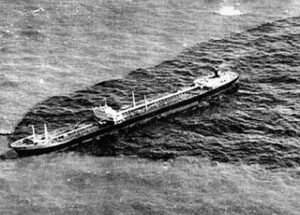 from RAF Chivenor to drop cans of aviation fuel to make the oil blaze. Unfortunately, exceptionally high tides put the fire out. The winds made it necessary to make further bombing runs by Sea Vixens from the RNAS Yeovilton and Buccaneers from the Royal Navy Air Station Brawdy, as well as more RAF Hunters with liquefied petroleum jelly, also known as napalm, to ignite the oil. The constant bombing lasted into the next day before the Torrey Canyon finally sank. About 161 1,000-pound bombs, 13,000 US gallons of kerosene, 3,600 US gallons of napalm and 16 other missiles had been aimed at the ship. Attempts to use foam-filled containment booms were mostly ineffectual because of the high seas. The disaster finally over, there was nothing left but the cleanup.
from RAF Chivenor to drop cans of aviation fuel to make the oil blaze. Unfortunately, exceptionally high tides put the fire out. The winds made it necessary to make further bombing runs by Sea Vixens from the RNAS Yeovilton and Buccaneers from the Royal Navy Air Station Brawdy, as well as more RAF Hunters with liquefied petroleum jelly, also known as napalm, to ignite the oil. The constant bombing lasted into the next day before the Torrey Canyon finally sank. About 161 1,000-pound bombs, 13,000 US gallons of kerosene, 3,600 US gallons of napalm and 16 other missiles had been aimed at the ship. Attempts to use foam-filled containment booms were mostly ineffectual because of the high seas. The disaster finally over, there was nothing left but the cleanup.
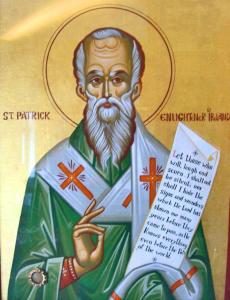
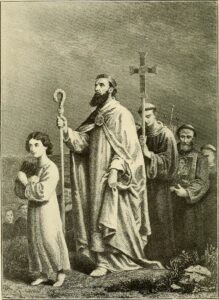 While I don’t believe in luck, my family does come from strong Irish roots. I believe in blessing, so when I go for the “wearin o’ the green” so that I don’t get pinched, I choose something with an Irish blessing on it instead of a “lucky horseshoe” to adorn my green. There are many Irish Blessings, and my favorites are the ones that emphasize that blessings come from God, not from luck. These days, Sait Patrick’s Day celebrations have little to do with the original purpose of the day. The day was originally a day to honor a man…Saint Patrick, who was known as the “Apostle of Ireland.” He was considered the primary patron saint of Ireland.
While I don’t believe in luck, my family does come from strong Irish roots. I believe in blessing, so when I go for the “wearin o’ the green” so that I don’t get pinched, I choose something with an Irish blessing on it instead of a “lucky horseshoe” to adorn my green. There are many Irish Blessings, and my favorites are the ones that emphasize that blessings come from God, not from luck. These days, Sait Patrick’s Day celebrations have little to do with the original purpose of the day. The day was originally a day to honor a man…Saint Patrick, who was known as the “Apostle of Ireland.” He was considered the primary patron saint of Ireland.
Saint Patrick originally came to Ireland very much against his will. He was about sixteen, when he was captured by Irish pirates from his home in Britain and taken as a slave to Ireland. He writes that he lived there for six years as an animal herder before finally escaping and returning to his family. You might have thought that after such an ordeal, he would never want to go back, but after becoming a cleric, he returned to spread Christianity in northern and western Ireland. Saint Patrick went on to become a bishop, but little is known about where he worked. Nevertheless, by the seventh century, he had come to be revered as the patron saint of Ireland. To think about what he went through, and then the very fact that he returned, definitely makes him a saint to me.
While partying and drinking green beer, parades and bars, and wearing green clothing all seem to be the 
 normal way of celebrating these days, the reality is that this is technically a very religious holiday that is all about forgiveness, and a love of the people of Ireland. Some places hold parades and go all out with a party, but some people still feel more reserved about the day. Time changes things. It used to be that in Ireland, Saint Patrick’s Day was “celebrated” with church services, prayer, and a feast, but in modern times, there are a variety of types of celebrations, and while partying tends to cause a loss of the real reason for the day, it is a sign of the times, I suppose. However you celebrate, I hope you all have a great holiday. Happy Saint Patrick’s Day everyone.
normal way of celebrating these days, the reality is that this is technically a very religious holiday that is all about forgiveness, and a love of the people of Ireland. Some places hold parades and go all out with a party, but some people still feel more reserved about the day. Time changes things. It used to be that in Ireland, Saint Patrick’s Day was “celebrated” with church services, prayer, and a feast, but in modern times, there are a variety of types of celebrations, and while partying tends to cause a loss of the real reason for the day, it is a sign of the times, I suppose. However you celebrate, I hope you all have a great holiday. Happy Saint Patrick’s Day everyone.
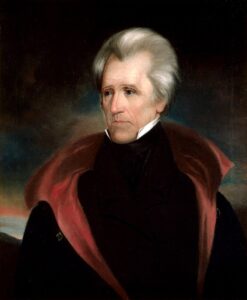 I’m not sure why it is that every president “needs” a pet. Nevertheless, it seems that it is expected, and the “first dog” seems to be the most common choice of pet. Dogs are the most commonly talked about pets in the White House…in recent years anyway. The fact is that ever since George Washington, there has been a myriad of different animals that earned the title of presidential pet or first pet. Some of the more manageable animals to come under the care of the president were cats, horses, donkeys, cows, goats, and hamsters. Oddly, there were also the more “unique” animals that lived in the White House too, including, and often only temporarily, bobcats, raccoons, lions, tigers, and bears, if you can believe it.
I’m not sure why it is that every president “needs” a pet. Nevertheless, it seems that it is expected, and the “first dog” seems to be the most common choice of pet. Dogs are the most commonly talked about pets in the White House…in recent years anyway. The fact is that ever since George Washington, there has been a myriad of different animals that earned the title of presidential pet or first pet. Some of the more manageable animals to come under the care of the president were cats, horses, donkeys, cows, goats, and hamsters. Oddly, there were also the more “unique” animals that lived in the White House too, including, and often only temporarily, bobcats, raccoons, lions, tigers, and bears, if you can believe it.
One of the more common kind of animals was the variety of birds that have worn the title pf presidential pet. Birds, such as turkeys, mockingbirds, parakeets, and several other species of parrot and songbird have been the companions of past presidents and their families. One of the presidents that had a bird was Andrew Jackson, the seventh president, who owned a variety of pets, among them, an African grey parrot named Poll that he had purchased for his wife, Rachel. Unfortunately, had very little influence on Poll, because she died of a heart attack not long after his election in 1828. Because of Rachel’s untimely death, and unlike other presidential parrots, Poll took on some of Jackson’s more unbecoming characteristics. To put it mildly, Andrew Jackson was 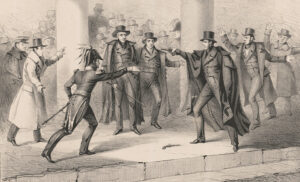 an exceptionally volatile individual who often disregarded formality. On the one hand, Jackson’s character helped him to actually survive an assassination attempt and to win the Battle of New Orleans. Both of these made him quite popular, even though the treaty that followed the battle, was almost pointless, and so the battle was viewed much the same. On the other hand, as both a general and later president, Jackson used every tool at his disposal to crush indigenous sovereignty. He really had no use for the Native Americans, or at least not for their rights as a sovereign nation. In fact, his actions both directly and indirectly caused the deaths of thousands of Native Americans.
an exceptionally volatile individual who often disregarded formality. On the one hand, Jackson’s character helped him to actually survive an assassination attempt and to win the Battle of New Orleans. Both of these made him quite popular, even though the treaty that followed the battle, was almost pointless, and so the battle was viewed much the same. On the other hand, as both a general and later president, Jackson used every tool at his disposal to crush indigenous sovereignty. He really had no use for the Native Americans, or at least not for their rights as a sovereign nation. In fact, his actions both directly and indirectly caused the deaths of thousands of Native Americans.
Nevertheless, where Poll was concerned, the loss of Rachel and Jacksons crude talk led to a number of problems later on. Poll was therefore almost constantly exposed to the already foul-mouthed and hot-tempered president. I don’t suppose all that matter very much to Jackson, who was obviously used to his own way of speaking, but on the day of Jackson’s funeral, it was decided by Jackson, that Poll was to be in attendance, 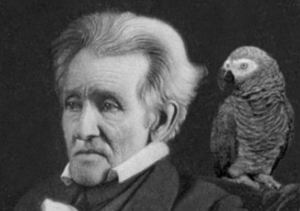 along with the grieving spectators. I can only imagine the guests, especially of that era, Jackson passed away on June 8, 1845, when after possibly being unnerved by the number of people, Poll proceeded to shock all of the guests when he began to exclaim all sorts of profanity and otherwise inappropriate language. According to witnesses, Poll’s outbursts were so disruptive that the bird had to be escorted away from the proceedings. Even after his departure, I’m sure that the prim and proper ladies and gentlemen had to take a moment to compose themselves before the funeral could continue. I guess it just goes to show that sometimes, more than just our children are listening to every word we say.
along with the grieving spectators. I can only imagine the guests, especially of that era, Jackson passed away on June 8, 1845, when after possibly being unnerved by the number of people, Poll proceeded to shock all of the guests when he began to exclaim all sorts of profanity and otherwise inappropriate language. According to witnesses, Poll’s outbursts were so disruptive that the bird had to be escorted away from the proceedings. Even after his departure, I’m sure that the prim and proper ladies and gentlemen had to take a moment to compose themselves before the funeral could continue. I guess it just goes to show that sometimes, more than just our children are listening to every word we say.

 My niece, Kellie Hadlock is one of those rare people who never seems to have a bad day. If she does, she certainly never shows it. She is always smiling and laughing. I remember my mom telling us that we shouldn’t frown because our face would get stuck like that. Well, Kellie’s face has certainly become stuck in a constant smile, and that is not a bad thing at all. Kellie shares her birthday with one of my favorite ancestors, my great aunt, Bertha Schumacher. I never met Aunt Bertha, but her journal has been a plethora of information on the Schumacher side of my family history for years now. Kellie isn’t a writer, nor is she specifically anything like Aunt Bertha, but they do share their special day…no charge for that tidbit…that was put in for free.
My niece, Kellie Hadlock is one of those rare people who never seems to have a bad day. If she does, she certainly never shows it. She is always smiling and laughing. I remember my mom telling us that we shouldn’t frown because our face would get stuck like that. Well, Kellie’s face has certainly become stuck in a constant smile, and that is not a bad thing at all. Kellie shares her birthday with one of my favorite ancestors, my great aunt, Bertha Schumacher. I never met Aunt Bertha, but her journal has been a plethora of information on the Schumacher side of my family history for years now. Kellie isn’t a writer, nor is she specifically anything like Aunt Bertha, but they do share their special day…no charge for that tidbit…that was put in for free.
Kellie’s sister, Jessi Sawdon tells me that Kellie is the fun aunt. Jessi lays claim to being the cool aunt, but every kid loves it more when Aunt Kellie is around. It’s easy to love Kellie, because she loves to laugh and loves life. Kellie loves singing and is one of the worship leaders at church. She and her dad, Chris Hadlock practice many songs at te house, while he accompanies her on the guitar. Her mom, Allyn loves those practice sessions. It’s 
 like having her own concert. Jessi’s daughter, Adelaide absolutely loves to sing like Aunt Kellie. As kids, Kellie’s older siblings, Jessi, Ryan Hadlock, and Lindsay Moore never missed an opportunity to tell Kellie to shut up, because she was always singing. Jessi has received a little payback these days, because now Adelaide is doing the same thing. The good news for Adelaide is that they don’t tell her to shut up. Jessi figures her mom felt the same way, you just can’t tell your sweet little girl not to sing…even if her siblings can. Kellie just does all the “Kellie things” and that makes her fun.
like having her own concert. Jessi’s daughter, Adelaide absolutely loves to sing like Aunt Kellie. As kids, Kellie’s older siblings, Jessi, Ryan Hadlock, and Lindsay Moore never missed an opportunity to tell Kellie to shut up, because she was always singing. Jessi has received a little payback these days, because now Adelaide is doing the same thing. The good news for Adelaide is that they don’t tell her to shut up. Jessi figures her mom felt the same way, you just can’t tell your sweet little girl not to sing…even if her siblings can. Kellie just does all the “Kellie things” and that makes her fun.
Kellie has become a knitting/crocheting extraordinaire. Jessi isn’t in to that stuff, so she isn’t sure she could tell the difference. Kellie learned a long time ago from her Meemaw (Ramona Hadlock), and seemed to like it, but she didn’t love it then, like she does now. These days, everyone enjoys watching Kellie as she quickly goes from start to finish of a project, and how great they look. Kellie has been doing a lot of crocheting. She has been considering starting a small business called Kingdom Crochet. Kellie makes hats, headbands, blankets, etc. And they are beautiful. This would be a “side gig” as she still 
 works at American Title, where she has been six years.
works at American Title, where she has been six years.
Kellie has been dating her boyfriend, Tim Thompson for a while now, and they are doing well. Kellie especially loves Tim’s sweet daughter, Jolene Thompson. Kellie took a trip to Cheyenne for Jessi’s birthday, and they all went out. They had a great time, and Jessi especially enjoys those visits, because they get her all to themselves. Today is Kellie’s birthday. Happy birthday Kellie!! Have a great day!! We love you!!

